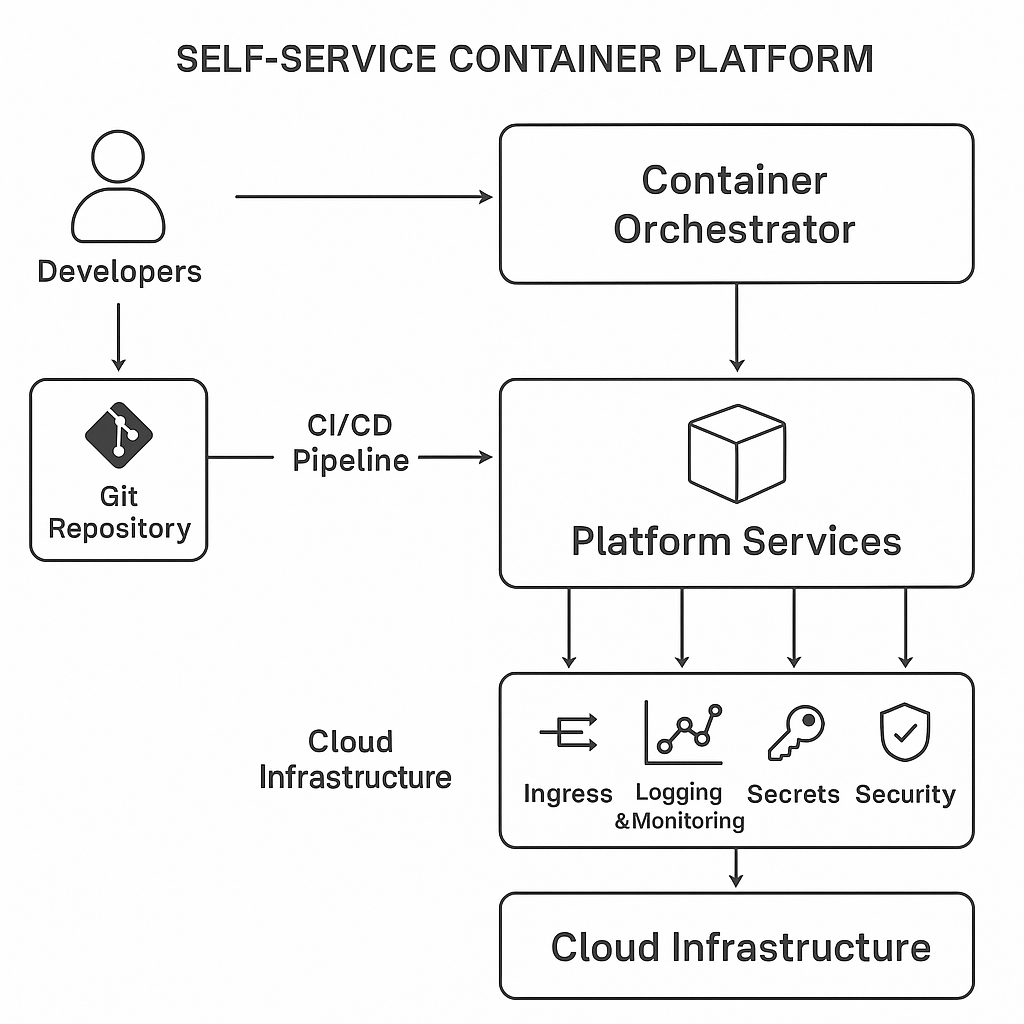Building a Cloud-Native Container Platform from Scratch - Part 1
Containers changed how we ship software, but they also made infrastructure more complicated. It’s easy to go from a simple Dockerfile to a sprawling mess of YAML, pipelines, and permissions. And if you’ve ever been on a team where shipping code means opening five tickets and waiting a week, you already know:
Developers don’t just need infrastructure. They need a platform.
In this series, we’re going to walk through how to build a secure, scalable, cloud-native platform that your engineers actually want to use. It’ll run containers, work in AWS or Azure, and give teams everything they need to deploy, monitor, and scale apps, without needing to become DevOps experts.
Full series
- Part 1: Why Build a Self-Service Container Platform (you are here)
- Part 2: Choosing Your Platform’s Building Blocks
- Part 3: Bootstrapping Your Infrastructure with Terraform
- Part 4: Installing Core Platform Services
- Part 5: Crafting the Developer Experience Layer
- Part 6: Scaling the Platform — Multi-Tenancy, Environments, and Governance
- Part 7: Day-2 Operations and Platform Maturity
- Part 8: The Future of Your Internal Platform
But before we get into Terraform or Kubernetes, let’s talk about why we’re doing this in the first place.
What Even Is a Platform?
A self-service container platform is not just a cluster with some pods on it. At its core, it’s:
- A golden path for application teams.
- A layer of abstraction over infrastructure.
- A secure, compliant foundation.
- A set of shared tools and services that ‘Just Work’.
Think of it as a product, built by platform engineers for internal teams, with a focus on developer experience, security by default, and operational observability.
If your platform doesn’t make it easier and faster for engineers to get things done, it’s not really a platform. It’s just a pile of tools.
Why Build Your Own?
There’s no shortage of tools out there: EKS, AKS, ECS, Azure Container Apps, Cloud Run, Heroku, Fly.io — so why build a platform at all?
Here are the most common (and valid) reasons we see:
-
You need consistency
Different teams are deploying apps in totally different ways. Some use GitHub Actions, some use Jenkins, some deploy from laptops. A platform gives you a single, sane deployment model across the org.
-
You want to enforce security without slowing people down
With a platform, you can:
- Enforce image scanning
- Block root containers
- Inject secrets securely
- Add audit logs
All without engineers needing to think about it.
-
You’re tired of reinventing the wheel
Every team ends up building the same stuff:
- Ingress
- TLS
- Dashboards
- Health checks
- CI/CD glue
Why not give it to them out of the box?
-
Your cloud bill is out of control
Platforms let you right-size workloads, autoscale properly, and kill off zombie environments — helping both FinOps and engineering teams.
-
You want to move faster, not slower
Ironically, building a platform can accelerate delivery. Done right, it shortens feedback loops, removes deployment bottlenecks, and improves team autonomy.
But Should You Build One?
Not every team needs a platform. Here’s a simple test:
| Question | If your answer is “yes”… |
|---|---|
| Do you have 5+ engineering teams? | It’s time to unify how things are deployed |
| Do you support multiple services or environments? | A platform makes managing dev/test/prod easier |
| Are engineers slowed down by infra complexity? | A golden path removes friction |
| Are you audited or security-conscious? | Platforms enforce policy and least privilege |
| Do you have a SRE/DevOps team? | Then you have the skills to build this right |
If you’re a startup with 2 devs and a Heroku account? You’re probably fine without one, for now.
What Will We Build in This Series?
We’re going to build a real, production-grade, cloud-native platform. Something you can deploy in AWS or Azure, with:
- A secure container orchestrator (e.g. EKS or AKS)
- GitOps-based deployments
- Built-in observability (metrics, logs, tracing)
- Secrets management
- Security guardrails
- Multi-environment support
- Templates and tools for self-service app delivery
And we’ll build it the right way: infrastructure-as-code, identity-first security, and automation at every layer.

Final Thoughts
Building a platform isn’t about chasing the latest CNCF tool. It’s about making it easier for teams to ship software without compromising on security, observability, or operations.
Over the next few posts, we’ll show you how to go from “we want containers” to a full-fledged platform with guardrails, golden paths, and developer joy baked in.
Ready?
Next up: Part 2: Choosing Your Platform’s Building Blocks — Kubernetes, ECS, or Something Else?

Leave a comment